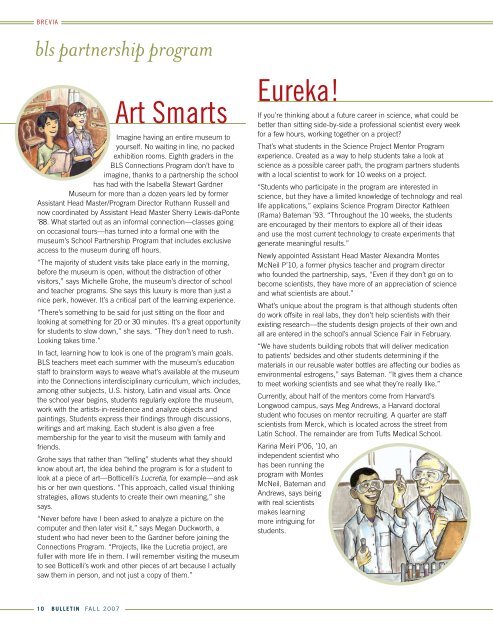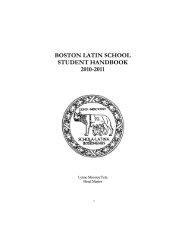A NEW DAY DAWNS - Boston Latin School
A NEW DAY DAWNS - Boston Latin School
A NEW DAY DAWNS - Boston Latin School
Create successful ePaper yourself
Turn your PDF publications into a flip-book with our unique Google optimized e-Paper software.
BreviA<br />
bls partnership program<br />
10 Bulletin fall 2007<br />
Art Smarts<br />
imagine having an entire museum to<br />
yourself. No waiting in line, no packed<br />
exhibition rooms. eighth graders in the<br />
BLS Connections Program don’t have to<br />
imagine, thanks to a partnership the school<br />
has had with the isabella Stewart Gardner<br />
Museum for more than a dozen years led by former<br />
Assistant head Master/Program Director Ruthann Russell and<br />
now coordinated by Assistant head Master Sherry Lewis-daPonte<br />
’88. What started out as an informal connection—classes going<br />
on occasional tours—has turned into a formal one with the<br />
museum’s <strong>School</strong> Partnership Program that includes exclusive<br />
access to the museum during off hours.<br />
“The majority of student visits take place early in the morning,<br />
before the museum is open, without the distraction of other<br />
visitors,” says Michelle Grohe, the museum’s director of school<br />
and teacher programs. She says this luxury is more than just a<br />
nice perk, however. it’s a critical part of the learning experience.<br />
“There’s something to be said for just sitting on the floor and<br />
looking at something for 20 or 30 minutes. it’s a great opportunity<br />
for students to slow down,” she says. “They don’t need to rush.<br />
Looking takes time.”<br />
in fact, learning how to look is one of the program’s main goals.<br />
BLS teachers meet each summer with the museum’s education<br />
staff to brainstorm ways to weave what’s available at the museum<br />
into the Connections interdisciplinary curriculum, which includes,<br />
among other subjects, U.S. history, <strong>Latin</strong> and visual arts. once<br />
the school year begins, students regularly explore the museum,<br />
work with the artists-in-residence and analyze objects and<br />
paintings. Students express their findings through discussions,<br />
writings and art making. each student is also given a free<br />
membership for the year to visit the museum with family and<br />
friends.<br />
Grohe says that rather than “telling” students what they should<br />
know about art, the idea behind the program is for a student to<br />
look at a piece of art—Botticelli’s Lucretia, for example—and ask<br />
his or her own questions. “This approach, called visual thinking<br />
strategies, allows students to create their own meaning,” she<br />
says.<br />
“Never before have i been asked to analyze a picture on the<br />
computer and then later visit it,” says Megan Duckworth, a<br />
student who had never been to the Gardner before joining the<br />
Connections Program. “Projects, like the Lucretia project, are<br />
fuller with more life in them. i will remember visiting the museum<br />
to see Botticelli’s work and other pieces of art because i actually<br />
saw them in person, and not just a copy of them.”<br />
eureka!<br />
if you’re thinking about a future career in science, what could be<br />
better than sitting side-by-side a professional scientist every week<br />
for a few hours, working together on a project?<br />
That’s what students in the Science Project Mentor Program<br />
experience. Created as a way to help students take a look at<br />
science as a possible career path, the program partners students<br />
with a local scientist to work for 10 weeks on a project.<br />
“Students who participate in the program are interested in<br />
science, but they have a limited knowledge of technology and real<br />
life applications,” explains Science Program Director Kathleen<br />
(Rama) Bateman ’93. “Throughout the 10 weeks, the students<br />
are encouraged by their mentors to explore all of their ideas<br />
and use the most current technology to create experiments that<br />
generate meaningful results.”<br />
Newly appointed Assistant head Master Alexandra Montes<br />
McNeil P’10, a former physics teacher and program director<br />
who founded the partnership, says, “even if they don’t go on to<br />
become scientists, they have more of an appreciation of science<br />
and what scientists are about.”<br />
What’s unique about the program is that although students often<br />
do work offsite in real labs, they don’t help scientists with their<br />
existing research—the students design projects of their own and<br />
all are entered in the school’s annual Science Fair in February.<br />
“We have students building robots that will deliver medication<br />
to patients’ bedsides and other students determining if the<br />
materials in our reusable water bottles are affecting our bodies as<br />
environmental estrogens,” says Bateman. “it gives them a chance<br />
to meet working scientists and see what they’re really like.”<br />
Currently, about half of the mentors come from harvard’s<br />
Longwood campus, says Meg Andrews, a harvard doctoral<br />
student who focuses on mentor recruiting. A quarter are staff<br />
scientists from Merck, which is located across the street from<br />
<strong>Latin</strong> <strong>School</strong>. The remainder are from Tufts Medical <strong>School</strong>.<br />
Karina Meiri P’06, ’10, an<br />
independent scientist who<br />
has been running the<br />
program with Montes<br />
McNeil, Bateman and<br />
Andrews, says being<br />
with real scientists<br />
makes learning<br />
more intriguing for<br />
students.



